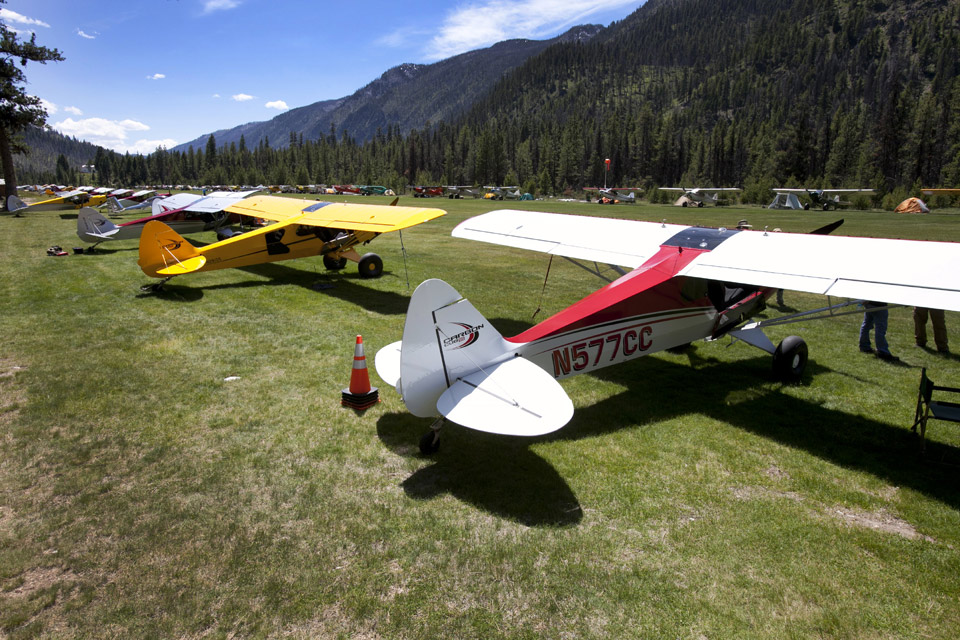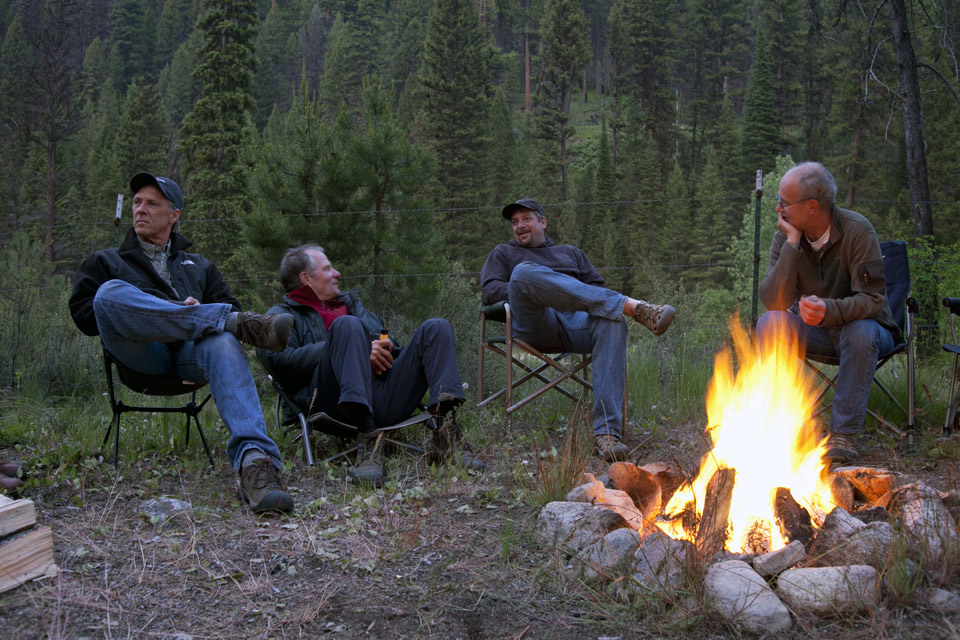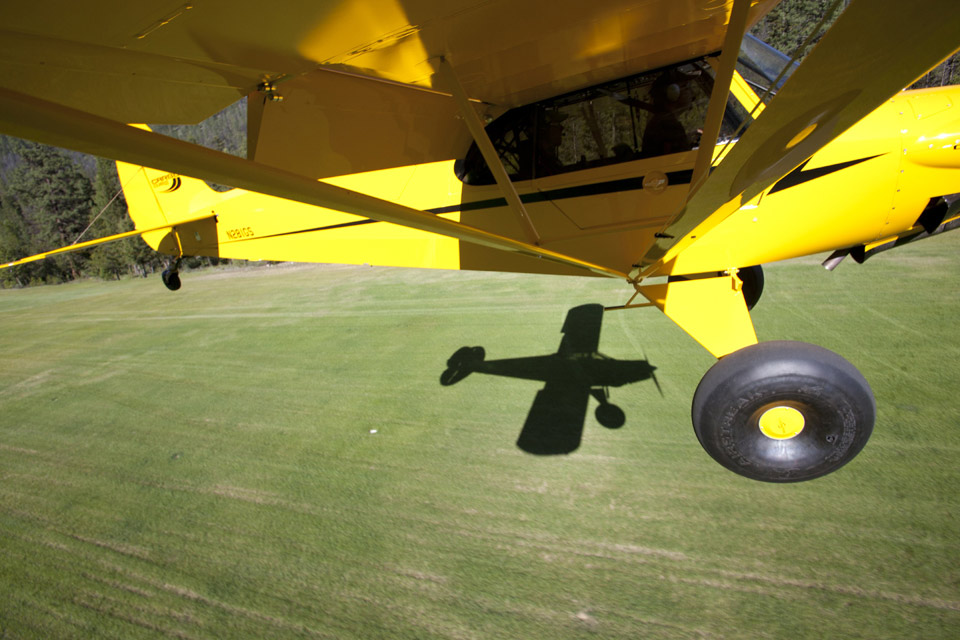National Bushwheel Awareness Week: Quirky gathering in the Idaho wilderness
Nothing remotely like it
Turbulent plumes of swirling mountain air jostle our pair of Carbon Cubs as we approach Johnson Creek Airport (3U2) for the start of National Bushwheel Awareness Week, a quirky annual gathering that attracts more than 100 backcountry airplanes and the STOL fanatics who fly them.
I’m following CubCrafters President Randy Lervold and his passenger, photographer Cameron Lawson, through the Bitterroot Mountain passes, between peaks jutting 10,000 feet or more into a cumulus-filled Idaho sky. When their airplane gets buffeted and tossed by a particularly sharp column of disturbed air, I know my turn is coming in about three seconds.
Snow still blankets the rocky peaks above us, even though we’re only a week from the summer solstice.
“It should smooth out once we drop down into the next valley,” Lervold says with practiced nonchalance as we clear the final ridgeline and begin our descent toward Yellow Pine, the tiny town that marks our entry to the valley leading to the grass landing strip that will be our home for the next three days.
Chimney smoke from a cabin on the valley floor rises in a wispy, nearly vertical column, a promising sign that the body slams are likely to end soon. “The wind at the surface looks pretty calm,” Lervold says.
True enough, the jolts recede, and I pull down on the lever at the left wing root, clicking it one, two, three times to set full flaps for landing. The 122.9 MHz multicom frequency has been largely silent during our single-file approach, and that’s somewhat of a surprise since scores of airplanes are expected at the event.
As the broad, green fairway of the 3,400-foot Johnson Creek landing strip comes into view, it’s ringed on three sides by a magnificently eclectic group of about 100 mostly backcountry airplanes lined wing tip to wing tip.
National Bushwheel Awareness Week launched a decade ago on the SuperCub.org website as a tongue-in-cheek joke, the name itself poking fun at the politically correct causes that promote themselves by laying claim to certain days, weeks, or months. The affliction here is an all-consuming desire to fly specialized airplanes to remote, rugged, and scenic places with like-minded pilots.
“It started with our disproportionate, uncontrollable, and borderline unhealthy urge to install big tires on our aircraft,” said Dave Kirsten, one of the founders. “Our goal has always been to get out and adventure with fellow pilots. For sure social media is what glues us all together. During the winter many of us sit at our computers and blog about summer flying. By the time spring rolls around we are busting at the seams and ready to go.”
Super Cubs and their many derivatives comprised about half of the 124 airplanes that showed up for the 2014 event. Others included Aviat Huskys; Cessna 180s, 182s, 185s, and 206s; Maules; Pipers ranging from PA–11s to a Cherokee Six, and Experimental Van’s RVs and Light Sport Just Aircraft SuperSTOL models.
I touch down behind Lervold and Lawson and follow them to the CubCrafters parking spot near the center of the action. The Yakima, Washington-based company has several new aircraft on display, and Marketing Manager John Whitish has volunteered to cook dinner for everyone in attendance. It’s a big job, and he’s been preparing for weeks. The centerpiece of his efforts is a Cub-themed keg of homebrewed beer by Cubcrafters founder Jim Richmond.
Idaho vs. Wisconsin
The epicenter of the Super Cub world isn’t Johnson Creek, however. It’s New Holstein, Wisconsin, where the annual Super Cub gathering coincides with EAA AirVenture in nearby Oshkosh each summer.
The organizers of National Bushwheel Awareness Week say Wisconsin is too far to go in slow airplanes, especially during the short summer in the Northwest when flying conditions are glorious. Also, Kirsten lives in Washington and works in agriculture, so July or early August are near his peak season.
“New Holstein is too far for some of us western-state Super Cub pilots to travel,” he said. “At Super Cub flying speeds, it would take 20 hours of hard flying to get there. And then we would have another 20 hours to get home. It was too great a time commitment to be out playing in airplanes for 10 days during planting season. We realized the solution was to start a new event for us Super Cubbers out West.”
Flying and friendship
Unlike other aviation events that are tightly choreographed with commerce taking center stage, here the emphasis is on flying and friendship. Individuals and small groups depart in the still morning air and find their way to the 20 or so strips along the south and middle forks of the Salmon River in the Frank Church Wilderness Area. They usually return around noon, stay on the ground during the turbulent portion of the afternoon, and then fly again in the evening just before dark.
There are no formal aircraft demonstrations, or short-takeoff or landing contests. But pilots are aware that their peers are watching each takeoff and landing—and they’re a tough crowd to impress.
A highly modified ag airplane fitted with tundra tires is one of my personal favorites, along with several pumped-up Maules—including an Experimental version with tires so big and soft they look like pumpernickel bagels.
Some seek out especially challenging “black diamond” airstrips such as Mile Hi or Dewey Moore—small, obstructed, high-altitude strips made world famous by YouTube clips. Others range much farther afield to scenic places such as Hell’s Canyon on the Snake River in northeastern Oregon, or southwestern Montana.
Each evening, pilots socialize around campfires and plan excursions for the next day.
There’s no control tower or air boss, and the unstructured flights seems to work well, even at a mostly one-way-in, one-way-out airport in a narrow, steep-sided valley.
Airplanes are generally headed out in the early morning and returning in the late mornings and late afternoons, so at least the flow goes the same direction. Even though just about everyone is on the multicom frequency, the line-of-sight radio transmissions don’t reach terribly far in the valleys and canyons where they are flying. Also, most of the backcountry airplanes in attendance tend to climb, cruise, and approach at similar speeds.
The Carbon Cub I’m flying is a factory demonstrator, the first of its kind to be equipped with the Garmin G3X Touch avionics system. Even though I’m a stranger in this region, the avionics system gives me the super power of knowing what’s around the next bend. It’s a tremendous comfort to a flatland flier to know that the river I’m following leads to lower terrain, and that my airplane’s climb rate is sufficient to clear a ridge 10 or even 20 miles ahead. The PFD also shows the wind strength and direction, and an ADS-B weather display can warn of rain, thunderstorms, or reduced visibility if those conditions were to appear.
“Mountain flying is all about preparation, and preserving your options,” Lervold says. “This avionics system may seem too sophisticated for a backcountry airplane. But it gives you the information you need to make good decisions.”
Flying out
Pilots gather around coffee pots in the pre-dawn darkness. There’s frost on the windshields, and the grass is crunchy underfoot despite the June calendar date. Even though the altitude at the runway is just 4,933 feet above sea level, the surrounding mountain peaks direct cold, high-altitude air to the valley floor each night.
There are hot showers available at Johnson Creek, but they are spoken for early, and the demand for hot water far outstrips supply. Even a bracing cold shower feels right, however, in preparation for a vigorous day of mountain flying.
Lervold of CubCrafters leads our flight of two into a stream of airplanes taxiing for departure, and controllers at Chicago’s O’Hare or Atlanta’s Hartsfield International airports would admire the way these backcountry pilots take off in a quick and steady succession without any oversight.
As we reach the top of a ridgeline, we break out of the shadows and into the blindingly bright morning sunlight. A meadow below teems with elk, and photographer Lawson points out a group of white mountain goats on a nearby hillside. I’ll have to take his word for it since I’m focused on Lervold’s yellow-and-silver airplane as it carves a curving path through this magnificent, three-dimensional wonderland. After an hour-long tour, we drop in at Sulphur Creek for breakfast, and then return to Johnson Creek for an afternoon siesta.
Our final departure from Johnson Creek is a short hop back to McCall, Idaho, for fuel that follows the same path we had traced on our arrival several days earlier. This time the air is smooth, the sun is behind us, and I’m able to savor the rugged beauty of an area that had passed by in a blur the first time. I try to burn every detail of these last moments in the mountains into my mind and preserve them for safekeeping. Not just the dramatic scenery, but the invigorating chill of the air spilling in through my partly open left window, the fresh smell of the pine forests a few hundred feet below, and the pure enjoyment on the faces of Lervold and Lawson a few wingspans away.
Johnson Creek is quiet and remote most of the year. But during National Bushwheel Awareness Week, there’s nothing remotely like it.
Email [email protected]
Airstrip bagging
Pilots are drawn to the wilderness by the same natural beauty that attracts hikers, climbers, rafters, and others who come for inspiration and exploration. But flying also has the potential to disrupt these other activities, and excessive noise, low flying, and repeated overflights can lead to new limitations on flying, and sometimes outright bans.
As recreational backcountry flying gains popularity, pilots seeking greater aviation challenges are using remote airstrips to test themselves and their aircraft. Little-known strips like Mile-Hi, Dewey Moore, Soldier Bar, and Lower Loon on the Middle Fork of the Salmon River in Idaho have become the “black diamonds” of backcountry flying for the skill and precision they require—and visiting pilots often seek to drop in on as many airstrips as possible in a day or a weekend.
This practice, known as airstrip “bagging,” is highly controversial among backcountry pilots. Some welcome the repeated takeoffs and landings as a way to popularize remote airstrips and expand one of aviation’s most exciting specialties. Other pilots, however, fear overuse of these unforgiving strips will lead to accidents, flight restrictions, and bans—and cast aviation in a negative light among others who value wilderness areas.
“As pilots, we tend to be totally focused on our airplanes and we tend not to consider the wilderness experience of others,” said Brian Thompson of Yakima, Washington, flight instructor and Stinson owner. “I encourage pilots who fly into these areas to land, park, and stay awhile. Don’t just go in and out of one strip after another.”
Thompson, 63, has flown extensively throughout the Northwest and Alaska, and he says pilots should consider the lessons of the Iditerod—a legendary dog sled race to Nome, Alaska, meant to celebrate the heroic effort to deliver serum during a diphtheria outbreak—when planning their own backcountry flights.
“It’s worthwhile to ask, ‘Do we have the serum flask?’” he said. “In other words, What’s the purpose of this trip? And how much risk are you willing to accept for the reward? If the reward is simply bragging rights, that’s not worth anything to me.”
A 2014 FAA report singled out airport bagging as an “inappropriate use” of backcountry strips and a threat to their future.
“Bagging a backcountry airstrip is the practice of flying to an airstrip for no other reason than for the pilot to boast of having flown there, and is widely considered disrespectful,” the report said. “Airstrips are to be used as portals to the backcountry. Bagging, especially of airstrips that are sensitive or in wilderness areas, was listed as a threat to backcountry strips.”
Lytle Johnson, a veteran seaplane pilot and instructor in McCall, Idaho, says pilots can minimize their impact on the wilderness through simple flying etiquette.
“Fly high, stay on the right sides of canyons, and if you don’t need it, by all means reduce your engine power and prop rpm,” he said. “Don’t make multiple takeoffs and landings at any one strip. Be cognizant of the impact we have on people on the ground.”
For example, rafters on the Middle Fork of the Salmon River are only allowed on the water by permit, and many have waited years for the opportunity to float down one of America’s most scenic rivers. Some rafters are on week-long journeys through areas where motorized ground and water vehicles aren’t permitted. The appearance of a low-flying aircraft, or multiple aircraft flying together, can be jarring.
Johnson teaches visiting pilots about the history of the area’s airstrips and how much effort goes into building and maintaining each one.
“Knowing some of the history gives pilots an appreciation of how these places came to be,” he said. “They were made for a wide variety of purposes, and they’re much more than just open spaces in which to show off your superior pilot skills. Pilots should fly with as much deference as they can, and that will go a long way to preserving access to these magnificent natural areas.” —DMH










